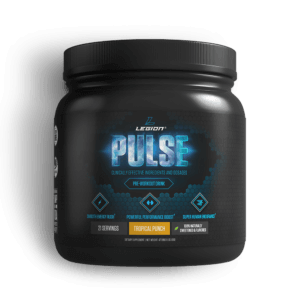“How the hell can I be this skinny with a stomach this big and fat?”
That’s the first line from an email I received earlier this week.
A picture followed and he looked more or less like this:
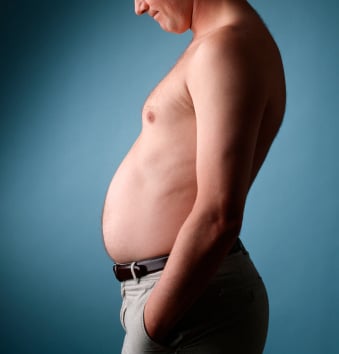
And it inspired this article.
You see, I’ve worked with thousands of men and women and if there’s one thing that frustrates people most, it’s having too much belly fat.
I’ve written quite a bit about how to lose belly fat, but visceral fat deserves its own treatment because it’s a different beast than the run-of-the-mill ab fat.
So, in this article we’re going to cover what visceral fat is, why it’s dangerous, why some people have more than others, and how to lose it.
Table of Contents
+
Want to listen to more stuff like this? Check out my podcast!
What Is Visceral Fat?
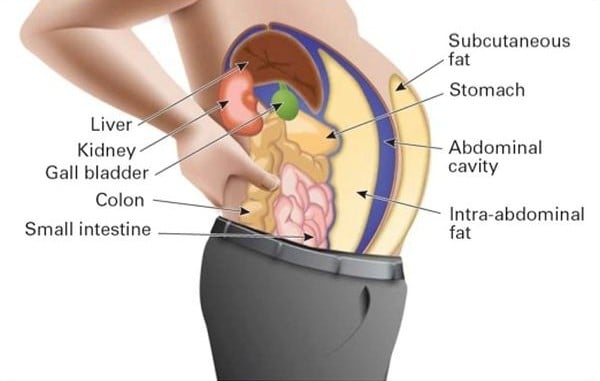
Visceral means “having to do with the organs, especially those in the abdominal cavity.”
Hence, visceral fat is body fat that’s stored around several organs in the abdominal cavity including the liver, pancreas, and intestines.
It differs from the type of body fat most people associate with “fat,” which is subcutaneous fat.
Subcutaneous means “situated under the skin,” which tells us what subcutaneous fat is: it’s fat that’s all over your body under your skin.
It’s what wiggles and jiggles and we we’re most concerned with when we want to lose fat.
Under normal conditions, subcutaneous fat levels are what fluctuate most when you “bulk” and “cut.”
Visceral fat, on the other hand, can’t be pinched–it lies beneath your abdominal wall.
In many cases, an expanding belly is the result of an increase in both types of fat. The subcutaneous fat is the fat we can feel and the visceral fat is the fat we can’t.
At this point, you might be wondering why some people can wind up with much more visceral fat than subcutaneous belly fat.
We’ll talk about why soon.
Now, while being too overweight is unhealthy, research shows that subcutaneous fat per se isn’t as dangerous to your health as visceral fat.
Higher amounts of visceral fat are associated with an increased risk of various types of disease including type 2 diabetes, heart disease, insulin resistance, and dyslipidemia.
Let’s find out why.
Why Is Visceral Fat Worse Than Subcutaneous Fat?
We know that visceral fat increases the risk of various types of disease whereas subcutaneous fat doesn’t, and there are several theories as to why this is.
One hypothesis that is panning out in clinical research is as follows:
- Visceral fat releases fatty acids and pro-inflammatory chemicals.
- Due the fat’s proximity to the portal vein, these chemicals find their way into the liver.
- This tainted blood causes problems in the liver including insulin resistance and steatosis.
- Health problems ensue.
Subcutaneous fat, on the other, release more beneficial than harmful chemicals, such as leptin and adiponectin.
Do You Have Too Much Visceral Fat?
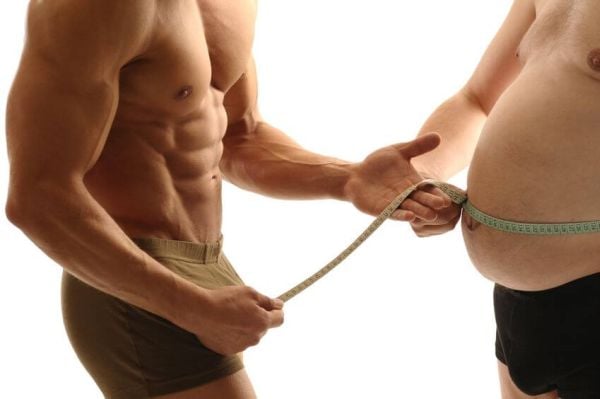
You can measure your total body fat percentage in several ways, but the simplest way to determine if you have too much visceral fat is to measure your waistline.
Grab a tape measure and wrap it around your waist at the level of your navel, like this:
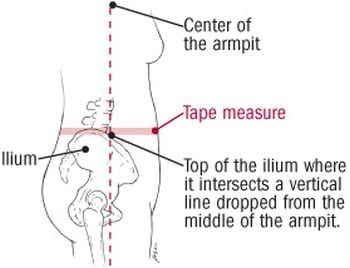
Don’t suck in your stomach or pull the tape tight enough to press into your skin.
In women, a waist measurement of 35 inches or higher is generally a sign of excess visceral fat. In men, it’s 40 inches or higher.
Why Some People Have Large Amounts of Visceral Fat
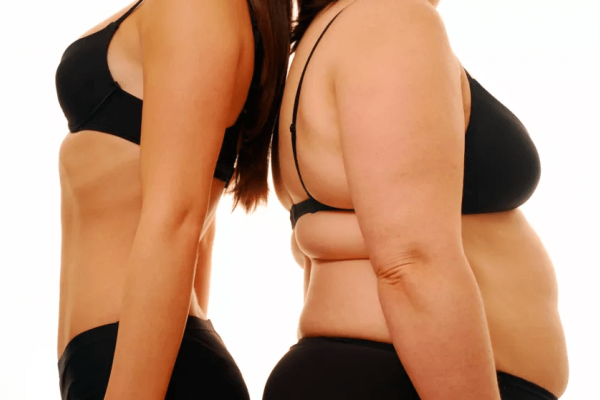
There are numerous factors that influence where you tend to gain fat, including genetics, hormones, age, and possibly even birth weight (smaller babies may be predisposed to gain more belly fat later in life).
For example…
- Research shows that several genes may be associated with increased levels of abdominal fatness.
- As people get older, they tend to move less and lose muscle.
This increases the risk of obesity and other disease and dysfunction, as well as the tendency to gain visceral fat.
- Post-menopausal women tend to store more visceral fat due to the hormonal changes that occur (primarily the decrease in estrogens).
There are diet and lifestyle risk factors, as well:
- High-fat diets, for example, are associated with higher levels of body fat (and the fatter someone is, the more visceral fat they will inevitably have).
- Sedentary living increases the risk of being overweight and having higher levels of visceral fat.
- Drinking large amounts of alcohol is associated with higher amounts of visceral fat in both men and women.
- Research shows that trans fats are preferentially stored as visceral fat.
This helps explain why visceral fat contains high amounts of trans fatty acids and why trans fat intake has been positively associated with abdominal fatness.
As you can see, genetics and hormones aside, the recipe for visceral fat gain is little-to-no exercise, overeating, eating crappy foods that contain trans fats, and drinking alcohol regularly.
Well, that’s exactly how the majority of people here in America live, which helps explain why we’re so damn sick and fat.
The good news, however, is losing visceral fat and keeping it off isn’t complicated.
How to Lose Visceral Fat
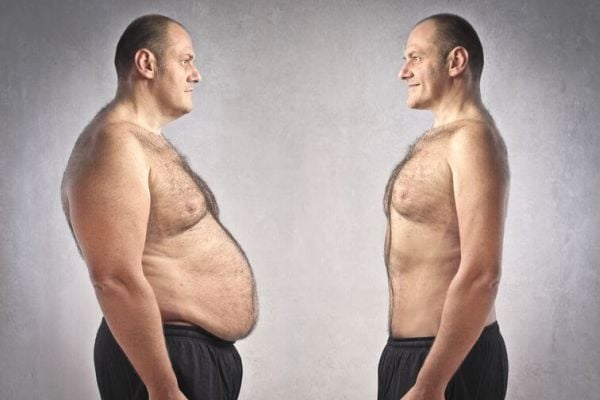
For all its menacing health implications, research shows that visceral fat yields easily to standard fat loss protocols.
Burn more energy than you consume and you will lose visceral fat, regardless of your genetics or other circumstances.
That said, there are a few other things you can do to speed up the process.
Cut out all trans fats from your diet.
There’s a reason why the Institute of Medicine recommends that our trans fat intake be “as low as possible.”
The stuff is bad.
Don’t drink a lot of alcohol.
What do we call a large accumulation of visceral fat?
A beer gut.
You now know why.
Studies show that while drinking frequency doesn’t seem to affect visceral fat levels, drinking intensity does. That is, the more you drink on each day you drink alcohol, the more likely you are to increase visceral fat stores.
So, if you’re struggling to lose visceral fat, cut back on the alcohol.
Do resistance training.
Weightlifting isn’t just for building muscle. Studies show it’s also extremely effective for losing visceral fat.
Read this article to learn how to create a resistance training program that will work for you.
Strategically use cardio to burn fat faster.
For best results do . . .
- At least two low- to moderate-intensity cardio workouts per week of 20-to-40 minutes each.
- One HIIT workout per week if you enjoy it.
- No more than 2-to-3 hours of cardio per week.
- Cardio and weightlifting on separate days. If that isn’t possible, lift weights first and try to separate the two workouts by at least 6 hours.
Improve your hormone profile.
You can’t increase your total fat mass without overeating, but your hormones can influence where your body stores the fat it does have.
For example, low testosterone is a predictor of visceral fatness in men (and as testosterone levels rise, visceral fatness drops).
In women, higher amounts of testosterone and lower amounts of estrogen (the hormonal shift that occurs during menopause) is associated with increased visceral fatness.
And when it comes to improving hormones, there are no (natural) quick fixes.
Men: Read this article to learn more about increasing testosterone naturally.
Women: It’s on my list to write an article for you that will discuss how to improve your hormone profiles. Stay tuned. 🙂
Keep cortisol levels under control.
Cortisol is a catabolic hormone that your body produces in response to stress.
Research shows that chronically high levels of cortisol skews the distribution of body fat to the abdominal region.
Check out this article to learn more about stress and cortisol and their relation to weight gain and loss.
Maintain good sleep hygiene.
Research shows that both too little and too much sleep can increase visceral fatness.
Scientists found clear associations between large increases in visceral fat and getting five hours of sleep or less and eight hours or more.
Read this article to learn more about maintaining good sleep hygiene.
Take the right supplements.
I saved this for last because, quite frankly, it’s far less important than proper diet and training.
Unfortunately, the workout supplement industry is plagued by pseudoscience, ridiculous hype, misleading advertising and endorsements, products full of junk ingredients, underdosing key ingredients, and many other shenanigans.
That said…there are safe, natural substances that have been scientifically proven to help you lose fat–and belly fat in particular–faster.
You’ll find my personal “belly fat loss stack” that I use and recommend below.
In the spirit of full disclosure, I want you to know that the supplements I recommend in this article are not just what I personally use but they are from my supplement line, LEGION.
As you probably know, the supplement industry is notorious for its lies and shenanigans. The truth is the majority of the supplements you see in the magazines and on the shelves aren’t going to help you reach your goals faster.
That’s why I decided to create the products I myself have always wanted: science-based formulations, clinically effective dosages of all ingredients, no fillers or unnecessary junk, and natural sweetening and flavoring.
You can learn more about LEGION and my goal to change the supplement industry for the better here.
If you like what you see and decide to support my work…you’re awesome. 🙂 It’s because of people like you that I get to spend my time writing articles like this that help others get into the best shape of their lives.
(And if you feel confused about what supplements you should take to reach your goals, take the Legion Supplement Finder Quiz to learn exactly what supplements are right for you. It’s the best way to ensure you get the most out of your supplement regimen.)
Caffeine
Millions of people can’t shake the cobwebs without their morning cups of coffee but this powerful compound has a lot more going for it.
Caffeine helps you lose weight by increasing the amount of energy your body burns throughout the day, and it also improves strength, promotes muscle endurance, and enhances anaerobic performance.
For best results, research has shown that caffeine is best delivered in a pill or powder format, though you must be careful to avoid building up a tolerance to it.
Personally I get my caffeine from my pre-workout PULSE, which also contains clinically effective dosages of 4 other ingredients scientifically proven to improve workout performance:
Yohimbine is a chemical extracted from a species of African plant, Yohimbe.
Studies show that yohimbine can accelerate fat loss by blocking the activity of alpha-receptors in fat cells.
This enables your body to reduce fat stores faster and is particularly useful as you get leaner and are battling with stubborn fat holdouts.
There’s a slight catch with yohimbine, though: elevated insulin levels negate its weight-loss effects. If you want to reap its fat loss benefits, you want to use it when you’re in a fasted state.
Yohimbine’s benefits don’t stop there, though. It does more than help you lose fat faster.
Research shows that yohimbine also improves exercise performance, and it’s particularly effective at fighting off physical fatigue and increasing time to exhaustion.
These are the reasons why I decided to include yohimbine in my pre-workout fat burner FORGE, which was made specifically for maximizing fat loss with fasted training.

PHOENIX Fat Burner
PHOENIX’s caffeine-free formulation helps you burn fat in three different ways:
- it dramatically increases metabolic speed,
- it amplifies the power of fat-burning chemicals produced by your body,
- and it increases the feeling of fullness from food.
Many companies try to sell you their fat burners by making the process of fat loss sound overly complex.
They talk about increasing fat oxidation rates, preserving lean mass, supporting the thyroid, inducing thermogenesis, inhibiting enzymes related to fat storage, inducing enzymes that cause fat loss, manipulating hormone and neurotransmitter levels, reducing water retention, improving nutrient partitioning, and more.
Well, the truth is these are all aspects of fat loss, but this type of marketing is little more than an attempt to dazzle you with terminology and scientific half-truths in hopes that you just accept the claimed benefits at face value.
When you take a cold, hard look at the science of fat loss, there are really only three ways to appreciably speed it up:
1. You can increase your basal metabolic rate.
Your metabolic rate is a “count” of how much energy your body burns throughout the day, and the higher it goes, the faster you can lose weight.
This is because when you boil fat loss down to its utmost simplicity, it’s determined by the difference between the energy your body burns and the energy you feed it with food. Expend more energy than you consume over time, and you’ll lose fat.
While there are many, many ways to increase metabolic rate, they ultimately rely on one or both of the following mechanisms:
- Encourage a cell to produce more energy from carbohydrates and fatty acids.
- Reduce the efficiency of the process through which cellular energy is produced, thus increasing the “energy cost” of meeting the body’s needs.
There are many ways to manipulate those mechanisms and PHOENIX focuses on the most effective methods.
2. You can prevent hunger or cravings from ruining your plans.
A major reason diets fail is people just aren’t able to stick to them long enough. Wishes turn into cravings and ultimately binges, which can undo days or even weeks of hard work if it really gets out of hand.
While some people have an easier time than others, almost everyone has to deal with hunger and cravings to one degree or another. It’s just human nature to want to indulge in food after accidental or intentional deprivation, and whether it’s normal or not, it’s still interfering with your goals.
Many compounds are known to reduce hunger and others are known to increase the sensation of fullness you get from a meal. When a combination of proven molecules is used effectively, you can successfully reduce hunger and cravings and derive the maximum benefits from your diet.
3. You can make the overall experience of dieting more enjoyable.
Make no mistake: while recreating your body with smart diet, exercise, and supplementation can dramatically change your life for the better, it’s not easy.
No amount of pills or powders are going to get you there. It takes hard work, and it takes time. And this is another major reason why diets fail: people don’t want to go through the discomfort of it all.
Well, like reducing hunger and cravings, making the process of dieting more enjoyable, primarily by increasing the overall feeling of well-being, makes it easy to stick to the plan and see it through.
Although the molecular machinery of fat loss is vast and complex, the practical application remains simple.
Contrary to what many other companies would lead you to believe, directly stimulating any of the thousands of proteins and enzymes involved in fat loss either doesn’t work or is uninvestigated.
Fat loss is a whole-body process, and by focusing on simple, key, and proven targets everything else activates and functions accordingly.
PHOENIX’s formulation is the result of an extensive scientific review of a wide variety of natural molecules known to favorably affect fat loss, and we carefully chose a handful that work synergistically to safely deliver consistent results on all three points given above.
My Personal Belly Fat Loss Routine

Before we wrap up, I want to share with you a simple “do this to lose belly fat faster” routine that has served me and thousands of people I’ve worked with well.
It starts with a 25% calorie deficit and a high-protein diet, and 4-to-5 hours of heavy weightlifting and 1-to-2 hours of cardio (mostly low-to-moderate-intensity cardio, such as walking, cycling, or rucking) per week.
In case you’re not sure how to calculate the calorie deficit, this tool will help:
Enter your email so we can send them to you.Want to save your results?
This is the “engine” that drives all the fat loss. Remember that no amount of supplementation will matter if you don’t get your diet and training right.
Once you do, though, supplementation can help. And here’s how my routine breaks down:
Before Weightlifting (Fasted):
About 10 minutes before my fasted weightlifting session, which I do first thing in the morning (about 45 minutes after waking), I take the following:
1 serving of FORGE
1 serving of PHOENIX
1 scoop of PULSE
My weightlifting session lasts about 45 to 60 minutes and afterward I eat my first meal of the week, which contains about 40 grams of protein and 100 grams of carbohydrate.
With Lunch:
I eat a light lunch of a salad with chicken so I can be back in a fasted state by 5:30 PM, which is when I do my fasted cardio.
If I were to eat a larger meal containing a fair amount of carbohydrate, however, there’s a chance that my insulin levels would still be elevated come cardio time. Thus, I “play it safe” and keep the meal small.
I don’t take any fat loss supplements at lunch.
(It’s worth noting that I also have a scoop of whey at about 3 PM, which gives my body about 2.5 to 3 hours to process it before cardio.)
Around 5:30 PM, Before Cardio
About 10 minutes before doing my fasted cardio, I take the following:
1 serving of FORGE
1 serving of PHOENIX
1 scoop of PULSE
I then do 20-to-40 minutes of low-to-moderate-intensity cardio on the recumbent bike and eat dinner after, followed by about 40 grams of protein an hour or so before bed.
Oh, and if you aren’t sure if the supplements discussed in this article are right for your budget, circumstances, and goals, then take the Legion Supplement Finder Quiz! In less than a minute, it’ll tell you exactly what supplements are right for you. Click here to check it out.
The Bottom Line on Visceral Fat

As you can see, there are more important reasons than vanity to lose the visceral fat.
It isn’t just ugly–it’s dangerous to your health.
Fortunately, though, it’s relatively easy to lose.
- Maintain a moderately aggressive calorie deficit
- Use weightlifting and cardio to drive your fat loss
- Cut out the trans fats and alcohol
- Adopt a hormone-healthy lifestyle
- Get enough (but not too much) sleep
- Take the right supplements
Follow that simple strategy and the bulging belly will slowly but surely disappear…for good.
What’s your take on visceral fat? Have anything else to share? Let me know in the comments below!
Scientific References +
- Hairston KG, Bryer-Ash M, Norris JM, Haffner S, Bowden DW, Wagenknecht LE. Sleep duration and five-year abdominal fat accumulation in a minority cohort: the IRAS family study. Sleep. 2010;33(3):289-295. doi:10.1093/sleep/33.3.289
- Moyer AE, Rodin J, Grilo CM, Cummings N, Larson LM, Rebuffé-Scrive M. Stress-induced cortisol response and fat distribution in women. Obes Res. 1994;2(3):255-262. http://www.ncbi.nlm.nih.gov/pubmed/16353426. Accessed September 26, 2019.
- Janssen I, Powell LH, Kazlauskaite R, Dugan SA. Testosterone and visceral fat in midlife women: the Study of Women’s Health Across the Nation (SWAN) fat patterning study. Obesity (Silver Spring). 2010;18(3):604-610. doi:10.1038/oby.2009.251
- Bhasin S. Effects of testosterone administration on fat distribution, insulin sensitivity, and atherosclerosis progression. Clin Infect Dis. 2003;37 Suppl 2:S142-9. doi:10.1086/375878
- Tsai EC, Boyko EJ, Leonetti DL, Fujimoto WY. Low serum testosterone level as a predictor of increased visceral fat in Japanese-American men. Int J Obes Relat Metab Disord. 2000;24(4):485-491. http://www.ncbi.nlm.nih.gov/pubmed/10805506. Accessed September 26, 2019.
- Ohkawara K, Tanaka S, Miyachi M, Ishikawa-Takata K, Tabata I. A dose-response relation between aerobic exercise and visceral fat reduction: systematic review of clinical trials. Int J Obes (Lond). 2007;31(12):1786-1797. doi:10.1038/sj.ijo.0803683
- Irving B a, Ph D, Davis CK, et al. Effect of exercise training intensity on abdominal visceral fat and body composition. Med Sci Sports Exerc. 2009;40(11):1863-1872. doi:10.1249/MSS.0b013e3181801d40.Effect
- Dutheil F, Lac G, Lesourd B, et al. Different modalities of exercise to reduce visceral fat mass and cardiovascular risk in metabolic syndrome: the RESOLVE randomized trial. Int J Cardiol. 2013;168(4):3634-3642. doi:10.1016/j.ijcard.2013.05.012
- Dorn JM, Hovey K, Muti P, et al. Alcohol drinking patterns differentially affect central adiposity as measured by abdominal height in women and men. J Nutr. 2003;133(8):2655-2662. doi:10.1093/jn/133.8.2655
- Study links steroid abuse to key biological, psychological characteristics – Harvard Gazette. https://news.harvard.edu/gazette/story/2009/04/study-links-steroid-abuse-to-key-biological-psychological-characteristics/. Accessed September 25, 2019.
- Dietary Reference Intakes for Energy, Carbohydrate, Fiber, Fat, Fatty Acids, Cholesterol, Protein, and Amino Acids (Macronutrients). National Academies Press; 2005. doi:10.17226/10490
- Rice T, Hong Y, Pérusse L, et al. Total body fat and abdominal visceral fat response to exercise training in the HERITAGE Family Study: evidence for major locus but no multifactorial effects. Metabolism. 1999;48(10):1278-1286. doi:10.1016/s0026-0495(99)90268-8
- Koh-Banerjee P, Chu N-F, Spiegelman D, et al. Prospective study of the association of changes in dietary intake, physical activity, alcohol consumption, and smoking with 9-y gain in waist circumference among 16 587 US men. Am J Clin Nutr. 2003;78(4):719-727. doi:10.1093/ajcn/78.4.719
- Bortolotto JW, Reis C, Ferreira A, et al. Higher content of trans fatty acids in abdominal visceral fat of morbidly obese individuals undergoing bariatric surgery compared to non-obese subjects. Obes Surg. 2005;15(9):1265-1270. doi:10.1381/096089205774512375
- Dietary Reference Intakes for Energy, Carbohydrate, Fiber, Fat, Fatty Acids, Cholesterol, Protein, and Amino Acids (Macronutrients). National Academies Press; 2005. doi:10.17226/10490
- Rice T, Hong Y, Pérusse L, et al. Total body fat and abdominal visceral fat response to exercise training in the HERITAGE Family Study: evidence for major locus but no multifactorial effects. Metabolism. 1999;48(10):1278-1286. doi:10.1016/s0026-0495(99)90268-8
- Koh-Banerjee P, Chu N-F, Spiegelman D, et al. Prospective study of the association of changes in dietary intake, physical activity, alcohol consumption, and smoking with 9-y gain in waist circumference among 16 587 US men. Am J Clin Nutr. 2003;78(4):719-727. doi:10.1093/ajcn/78.4.719
- Bortolotto JW, Reis C, Ferreira A, et al. Higher content of trans fatty acids in abdominal visceral fat of morbidly obese individuals undergoing bariatric surgery compared to non-obese subjects. Obes Surg. 2005;15(9):1265-1270. doi:10.1381/096089205774512375
- Bendsen NT, Chabanova E, Thomsen HS, et al. Effect of trans fatty acid intake on abdominal and liver fat deposition and blood lipids: A randomized trial in overweight postmenopausal women. Nutr Diabetes. 2011;1(1). doi:10.1038/nutd.2010.4
- Dorn JM, Hovey K, Muti P, et al. Alcohol drinking patterns differentially affect central adiposity as measured by abdominal height in women and men. J Nutr. 2003;133(8):2655-2662. doi:10.1093/jn/133.8.2655
- Slentz CA, Aiken LB, Houmard JA, et al. Inactivity, exercise, and visceral fat. STRRIDE: a randomized, controlled study of exercise intensity and amount. J Appl Physiol. 2005;99(4):1613-1618. doi:10.1152/japplphysiol.00124.2005
- Blundell JE, Lawton CL, Cotton JR, Macdiarmid JI. Control of human appetite: implications for the intake of dietary fat. Annu Rev Nutr. 1996;16:285-319. doi:10.1146/annurev.nu.16.070196.001441
- Garaulet M, Pérez-Llamas F, Baraza JC, et al. Body fat distribution in pre-and post-menopausal women: metabolic and anthropometric variables. J Nutr Health Aging. 2002;6(2):123-126. http://www.ncbi.nlm.nih.gov/pubmed/12166365. Accessed September 26, 2019.
- Koh-Banerjee P, Chu N-F, Spiegelman D, et al. Prospective study of the association of changes in dietary intake, physical activity, alcohol consumption, and smoking with 9-y gain in waist circumference among 16 587 US men. Am J Clin Nutr. 2003;78(4):719-727. doi:10.1093/ajcn/78.4.719
- Bortolotto JW, Reis C, Ferreira A, et al. Higher content of trans fatty acids in abdominal visceral fat of morbidly obese individuals undergoing bariatric surgery compared to non-obese subjects. Obes Surg. 2005;15(9):1265-1270. doi:10.1381/096089205774512375
- Bendsen NT, Chabanova E, Thomsen HS, et al. Effect of trans fatty acid intake on abdominal and liver fat deposition and blood lipids: A randomized trial in overweight postmenopausal women. Nutr Diabetes. 2011;1(1). doi:10.1038/nutd.2010.4
- Dorn JM, Hovey K, Muti P, et al. Alcohol drinking patterns differentially affect central adiposity as measured by abdominal height in women and men. J Nutr. 2003;133(8):2655-2662. doi:10.1093/jn/133.8.2655
- Slentz CA, Aiken LB, Houmard JA, et al. Inactivity, exercise, and visceral fat. STRRIDE: a randomized, controlled study of exercise intensity and amount. J Appl Physiol. 2005;99(4):1613-1618. doi:10.1152/japplphysiol.00124.2005
- Blundell JE, Lawton CL, Cotton JR, Macdiarmid JI. Control of human appetite: implications for the intake of dietary fat. Annu Rev Nutr. 1996;16:285-319. doi:10.1146/annurev.nu.16.070196.001441
- Garaulet M, Pérez-Llamas F, Baraza JC, et al. Body fat distribution in pre-and post-menopausal women: metabolic and anthropometric variables. J Nutr Health Aging. 2002;6(2):123-126. http://www.ncbi.nlm.nih.gov/pubmed/12166365. Accessed September 26, 2019.
- Yamada M, Moriguch Y, Mitani T, Aoyama T, Arai H. Age-dependent changes in skeletal muscle mass and visceral fat area in Japanese adults from 40 to 79 years-of-age. Geriatr Gerontol Int. 2014;14 Suppl 1:8-14. doi:10.1111/ggi.12209
- Goisser S, Kemmler W, Porzel S, et al. Sarcopenic obesity and complex interventions with nutrition and exercise in community-dwelling older persons--a narrative review. Clin Interv Aging. 2015;10:1267-1282. doi:10.2147/CIA.S82454
- Speakman JR, Westerterp KR. Associations between energy demands, physical activity, and body composition in adult humans between 18 and 96 y of age. Am J Clin Nutr. 2010;92(4):826-834. doi:10.3945/ajcn.2009.28540
- Katzmarzyk PT, Pérusse L, Bouchard C. Genetics of abdominal visceral fat levels. Am J Hum Biol. 1999;11(2):225-235. doi:10.1002/(SICI)1520-6300(1999)11:2<225::AID-AJHB10>3.0.CO;2-J
- Wells JCK, Chomtho S, Fewtrell MS. Programming of body composition by early growth and nutrition. Proc Nutr Soc. 2007;66(3):423-434. doi:10.1017/S0029665107005691
- Rankinen T, Kim SY, Pérusse L, Després JP, Bouchard C. The prediction of abdominal visceral fat level from body composition and anthropometry: ROC analysis. Int J Obes Relat Metab Disord. 1999;23(8):801-809. http://www.ncbi.nlm.nih.gov/pubmed/10490780. Accessed September 26, 2019.
- Rytka JM, Wueest S, Schoenle EJ, Konrad D. The portal theory supported by venous drainage-selective fat transplantation. Diabetes. 2011;60(1):56-63. doi:10.2337/db10-0697
- Item F, Konrad D. Visceral fat and metabolic inflammation: the portal theory revisited. Obes Rev. 2012;13 Suppl 2:30-39. doi:10.1111/j.1467-789X.2012.01035.x
- Hamdy O, Porramatikul S A-OE. Metabolic obesity: the paradox between visceral and subcutaneous fat. Curr Diabetes Rev. 2006;2(4):367-373. https://www.ncbi.nlm.nih.gov/pubmed/18220642. Accessed September 26, 2019.
- Klein S, Fontana L, Young VL, et al. Absence of an effect of liposuction on insulin action and risk factors for coronary heart disease. N Engl J Med. 2004;350(25):2549-2557. doi:10.1056/NEJMoa033179
